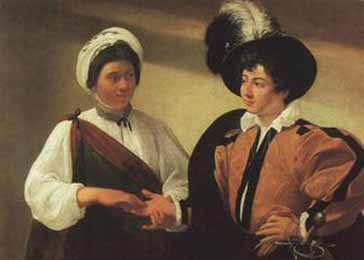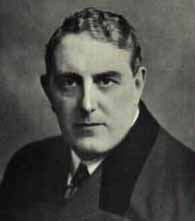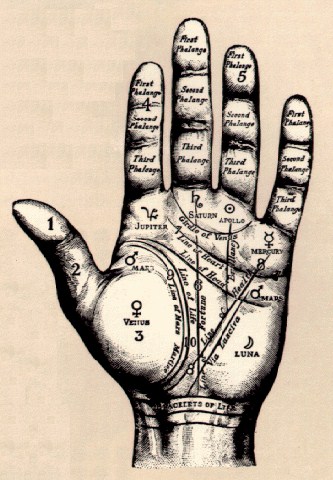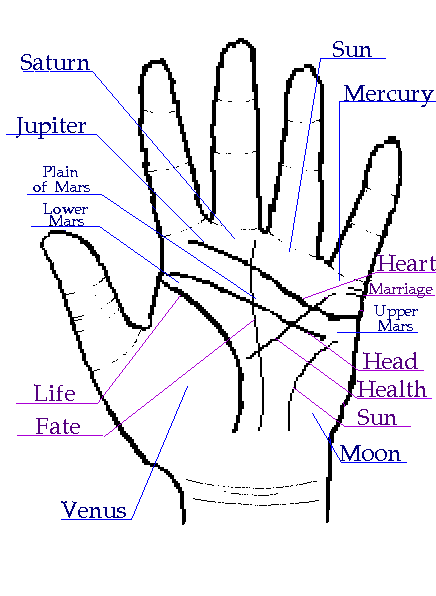Palmistry, also known as Cheiromancy, is my favorite tool of divination, as lines never lie. They are the blueprint of your experience in this reality. The palms of the hand are further used for healing by many healers and can experience energy if you focus. The left acts to receive energy while the right hand sends it out.
Chiromancy or 'cheiromancy', is the art of characterization and foretelling the future through the study of the palm, also known as palmistry, palm-reading, chirology or hand analysis. The practice is found all over the world, with numerous cultural variations. Those who practice chiromancy are generally called palmists, palm readers, hand readers, or chirologists.
Palmistry can trace its roots back to Indian (Hindu) Astrology (known in Sanskrit as Jyotish) and Roma (gypsy) fortune tellers. The Hindu sage Valmiki is thought to have written a book, whose title translates in English as "The Teachings of Valmiki Maharshi on Male Palmistry", comprising 567 stanzas, more than 5,000 years ago.
From India, the art of palmistry spread to China, Tibet, Egypt, Persia and to other countries in Europe. Palmistry came to China in around 3,000 B.C. It then progressed to Greece where Anaxagoras practised it. However, modern palmists often combine traditional predictive techniques with psychology, holistic healing, and alternative methods of divination.
The practice of chiromancy is generally regarded as a pseudoscience. It should be noted that the information outlined below is briefly representative of modern palmistry; there are many, often conflicting, interpretations of various lines and palmar features across various "schools" of palmistry.
Chiromancy consists of the practice of evaluating a person's character or future by "reading" the palm of that person's hand. Various "lines" ("heart line", "life line", etc.) and "mounts" (or bumps) (chirognomy) , purportedly suggest interpretations by their relative sizes, qualities, and intersections. In some traditions, readers also examine characteristics of the fingers, fingernails, fingerprints and palmar skin patterns (dermatoglyphics), skin texture and color, shape of the palm, and flexibility of the hand.
A palm reader usually begins by reading the person's 'dominant hand' (the hand he or she writes with or uses the most). In some traditions of palmistry, the other hand is believed to carry past-life or karmic information, as well as hereditary traits which is not the case. One lines form on the palm they remain there. New lines are created as a person experiences life.

Palmistry is an ancient practice that can be found dating back thousands of years. The prehistoric caves in France and Spain display hand drawings of palms with the major lines portrayed in amazing detail. Judging by the number of hands painted in prehistoric caves it would seem the human hand held a interest for humans since the stone age. Archaeological discoveries have discovered hands made of stone, wood and ivory by ancient civilizations. The use of the palm of the hand as a tool for healing, a link between man and god, as been repeated over and over again in history.
The basic framework for Classical Palmistry (the most widely taught and practiced tradition) is rooted in Greek mythology. Each area of the palm and fingers is related to a god or goddess, and the features of that area indicate the nature of the corresponding aspect of the subject. For example, the ring finger is associated with the Greek god Apollo; characteristics of the ring finger are tied to the subject's dealings with art, music, aesthetics, fame, and harmony. Aristotle (384-322 b.c) discovered a treatise on Palmistry on an altar to the god Hermes. The Greek physicians Hippocrates and Galen (ad 130-200) were both knowledgeable about the use of palmistry as a clinical aid.
The emperor of China used his thumbprint when sealing documents in 3000 BC. Information on the laws and practice of hand reading have been found in Vedic scripts, the bible and early Semitic writings.
The ancient Vedas, the earliest sacred Hindu writings, studied the hands as a means to unveil and understand the self and relationships with others. Here began an understanding that the unique patterns of lines and signs in the hand are a direct result of the way we think - consciousness creating the human blue for experiece.
Julius Caesar is said to have judged his men by palmistry.
An early writing using the word Palmistry - spelled 'Pawmestry' - was written in 1420 by John Lyndgate in his Assembly of Gods documents.
The first book on Palmistry was Michael Scotts De Philsiognomia written in 1477 on the physiognomy of the human body with a chapter on all the aspects of the human hand. He wrote, Just as a pebble thrown into the water creates ripples, so our thoughts create similar effects on our palms.
In the seventeenth century many books were written that included the early gypsy ideas about the hand that had been handed down through tradition since the early 1400s.
The practice of palmistry was unfortunately forced underground by the Catholic Church who branded it devil worshiping.
By the eighteenth century books were written blending some scientific information about the hand with mysticism. Since then Palmistry was aligned with the idea that a person read the hand with a scientific eye and spoke from intuition. Palmistry then was a form of prediction that was as individual as the hand.
Just as today's consciousness is awakening from the darkness into the light - religious paradigms losing their ontrol over humany thinking - so too did palmistry awakening as a tool of divination linked to the working of the mind. One must never forget that consciousness creates reality.
And so evolved the
Marie Anne le Norman was a famous French fortune teller in Napoleon's court who created great interest in Palmistry because of her predictive successes with Napoleon and Josephine. Two other Frenchmen DArpentigny born in 1798 and Desbarrolles born in 1801 wrote on the subject.
Dr Carl Carus, physician to the king of Saxony in the 19th century matched palms to personality.
Patrick "The Mysterious" Goodden, was said to be able to predict someone's exact date of death by looking at someone's hand. He died in 1875 and ironically predicted the completely wrong day of death.
Alex "The Mighty" Bernas, it has been said, could not only predict date of death but also the cause of death. He was known to heal as well and was not only revered as a chiromancer but also a witch doctor.
Cheiro, as he is known by nickname, was said to have predicted correctly dates and events in the lives of many renowned celebrities, including Marilyn Monroe, and even his own death.

Cheiro (1866-1936), was one of the most famous and colorful occult figures of the early Twentieth Century, Cheiro was a clairvoyant who used palmistry (or cheiromancy), astrology, and Chaldean numerology, to make startlingly accurate predictions, including world events. Born in Ireland as William John Warner, Cheiro also went by the name Count Louis Hamon, claiming a noble ancestry that may or may not have been accurate. His name, Cheiro, derives from the word cheiromancy.
There has always been skepticism about palmistry. Yet in the 21st century people study the lines on the hands with children born with various challenges such as autism, Downs Symdrom, ADD, among others. There often is a correlation which one day may help in early diagnosis of childhood illnesses which go undetected in early childhood.
As a special education teacher for many years, I can tell you that patterns do follow with learning challenges and genetically inherited diseases.
As we know, homosexuality is inherited. There is a 'V' shaped line on the hand that is found in all gay people and which I have shown to my clients.
All genetic markers are prominent on the hand if one knows where to look -- this is science not metascience.
As we came to study the lines on the fingers as a personal blueprint of signature for an individual, forensic research would determine that fingerprints were unique to each individual. In 1901 Scotland Yard adopted the technique of fingerprinting in criminal investigation and identification. Fingerprint identification is sometimes referred to as dactyloscopy. It involves the process of comparing questioned and known friction skin ridge impressions from fingers, palms, and toes to determine if the impressions are from the same finger. The flexibility of friction ridge skin means that no two finger or palm prints are ever exactly alike even two impressions recorded immediately after each other. Fingerprint identification occurs when an expert (or an expert computer system operating under threshold scoring rules) determines that two friction ridge impressions originated from the same finger or palm (or toe, sole) to the exclusion of all others.
Medical researchers studying skin patterns - Dermatoglyphics - have discovered a correspondence between genetic abnormalities and unusual markings in the hand. Research has confirmed a link between specific fingerprint patterns and heart disease.

Some people study the palm simply by looking at it and tapping inot messages they receive intuitively. Palmists - such as myself with create a palm bring using black Speedball water soluble ink placed on piece of paper or file folder. The lines are carefully outlined and detailed for the person - the final interpretation lending itself to a combination of rote and psychic messages which I carefully outline on the palm print.
Clients who cannot come here for a reading, send me a xeroed copy of their palm print for analysis.
Everything matters in Palmistry...the size of the hand, it's shape, color,texture, the nails, depth of lines, even the manner in which you hold your hands when I read your palm.
The hand you use to write with is your dominant hand. The lines on this hand change through the years due to the electromagnetic images from your brain which know your lifepath. Lines can add on. Once added they do not go away.
The other hand is your destiny hand. It generally remains the same throughout your lifetime. I do not consider it your last lifetime as both hands are generally similar.
Ovals on the heart denote line-divorce, separation. A long heart line: Overly romantic. A straight heart line: The mind rules the heart. The heat lines ends on the Jupiter mount: You want to control relationships
Above the heart line: A "V" denotes empathic qualities. A "U" from the Jupiter to the Apollo finger: Gay person
Horizontal lines under the Mercury finger: Karmic relationships: Long lines that run across the palm of the hand to the Mount of Venus (past lives) (thumb) denote marriages or 'living together'. (They are marked the same way).
Vertical lines: Full ones that cross horizontal lines: Your children should you decided to have any. Short lines: Miscarriages, abortions. (This will come up on the father's hand as well).
Head Line: Education: College--crosses the entire palm. Masters Program--has branches from the primary Head Line. Small branches: Other courses of study.
Life Line: Surround Venus Mount (thumb) Starts from above the thumb and goes to the wrist. If not connected to the Head Line: Caretaker, independent thinker, will give a lot in this lifetime, usually first or last child in the family-- or the only child (if the space is really wide). Double line: Depression, needs therapy at some point. A "V" closer to the wrist: a divorce A split in the line: Moving far, changing destiny
Lines that follow the Life Line of your Venus Mount (thumb area): Spirit Guides, Past Lives
Fate / Career / Destiny Line: Runs from the wrist straight up to the Saturn (middle finger). Career / careers: will often branch in many directions which will determine changes in career and goals in one's lifetime. Doubled line denotes: working at 2 careers at the same time.
Travel lines: Run along the outside palm from the heart line to the wrist. This needs to be viewed with a palm print to see where the person will travel next! Many lines: Traveling for business as well as pleasure. A few long lines: Major trips that change your destiny, often seen in the old years.
Money lines: From outside of the Venus Mount to the heart line. Run upward from the wrist. May have stars, bars or various other markings to indicate money and how you will get it. A wide "V" in that area: cash settlement. Darker / deeper lines: Finances increase Scattered lines: Make lost of money but at various times in your life. Palm prints denote: white space in that area: you will lend money but never get it back: learning lessons with money. How many lessons depends on how many white areas are between the life line and the thumb on your palm print.
Other lines: Pentagrams [goddess energies], Stars, Circles, Triangles, The letter "M", the letter "V".
All markings depend on the area of the hand where they are found.
Many markings do not mean an old soul. Many men have few lines and are old souls. Blue collar workers have fewer lines--usually just the basic lines.
Divided into 3 sections each with a different reference on each finger. Length of each section, and images on your palm print tell much.
Jupiter finger: Leadership, Self Esteem, The Teacher, Organization, Punctuality, The Limelight. A strong determined person will always have a long Jupiter finger, as do teachers, and performers.
Saturn Finger: Destiny, The Corporate World, Karma Long finger: Lots of karma to work out. Section closest to palm: Your family Section in the middle: Business world Section near the tip of the finger, your spiritual path
Apollo Finger: Creative, Metaphysical, Health If it points to the Saturn finger: Your have karma in the metaphysical realms.
Mercury Finger: Communications: Writing, Computers, Media Much can be gleamed in this area with a palm print as so many people are in the communication fields now. A short finger: does not go up as high as the third section on your Apollo finger: Not great with writing, but will overcome this by working with others. It the Mercury finger bends in: You hold back what you need to say!
Venus finger: How stubborn / or giving you are. It can be straight (stubborn) ---or bent (subtle)--the giver. Please check both hands as they may be different. i have one of each type!
The lengths of the Jupiter and Apollo fingers must be compared. If the Jupiter finger is shorter the person is often a late bloomer as he / she will follow the dictates of others and will not seek their own goals until their thirties.
Spaces between fingers: Wide between Saturn and Jupiter: Will overspend
Holding out the hands: When hands are placed down on the paper for the palm print: Wide open: Friendly, outgoing. Big space between the Mercury (pinky) and Apollo (ring) fingers: Will move, needs lots of freedom and space.

THE MOUNTS
Jupiter (under index finger) - religion, pride, respect
Saturn (under 2nd finger) - morbidness, sadness, interpersonal relationships.
Sun (under ring finger) - artistic talent
Mercury (under pinky finger) - inventiveness
Upper Mars (directly under the Mount of Mercury) - courage
Moon (directly under Upper Mars, large) - imagination
Venus (under thumb, across from Moon) - love
Lower Mars (above Venus, across from Upper Mars) - indifference




1 comments:
Thank you. This is a very comprehensive overview of palm reading.
Post a Comment